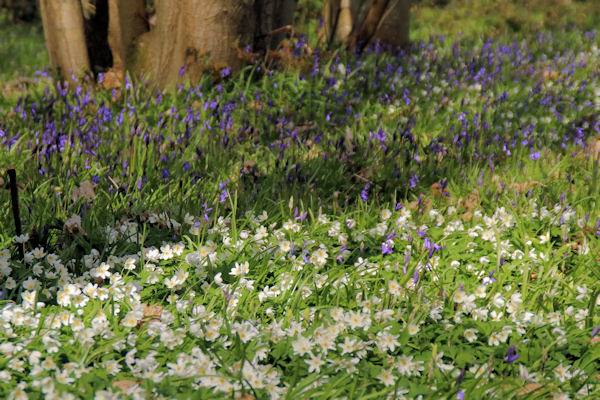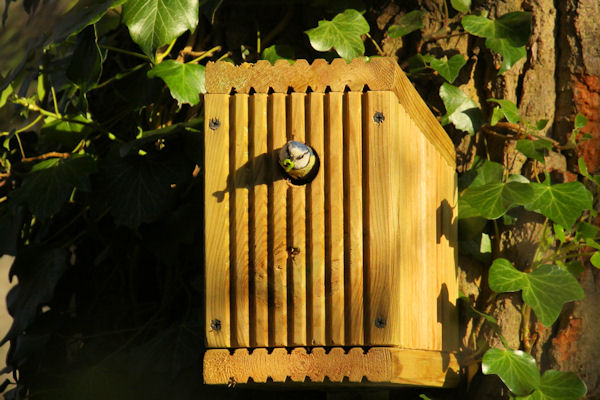April in Bicknor Wood
A Blackcap was heard singing on April 7th and was seen shortly after. The male has the eponymous topper whilst the female prefers hers in chestnut. On the 8th, two males were seen in dispute with three altogether. A female wasn't seen until the 17th. when she was seen in the sallow by the west gate with a male in attendance. 6 were seen by 29th.
A Chiffchaff was seen carrying a feather to line its nest and a Mistle Thrush has been singing from the top of Folk Oak on the 14th. The thrush was subsequently seen carrying twigs for a nest on 30th.
Sadly a nest in the same tree was savaged the next day and they may have felt that the loose bark would have given very little protection. But they found a new site very quickly and were seen on 13th, carrying nesting materials for a new nest in a much more secure location. On the 27th their decision was shown to have been prescient as the original nest was destroyed.
The Nuthatches have become very restless and are checking out a third potential nesting site. After putting in some effort on two cavities, they have abandoned them both and are looking again. They obviously like the neighbourhood, but are having trouble deciding exactly where to settle.
After 6 weeks of effort, the Blue Tits in the burnt tree have been breached. The lower hole was knocked through in their enthusiasm for a basement room, leaving them vulnerable to woodpeckers. It is not known if they had started laying, but the woodpeckers clearly expected to find something in there. Look carefully and tell me if you think that there are teeth marks around this hole?
Bird box no.9 has been receiving the attentions of Blue Tits with nesting material being shipped in with great urgency. It is possible that this is the pair from the burnt tree, or perhaps the ones that were forcibly evicted from No.22. The original damage was caused by woodpeckers, but it looks as if squirrels might also have had a hand (paw, incisor) in it too. It's a rough neighbourhood on the southside!
The drain slot beneath many of the boxes has proved to be a sign of nesting activity, whether intended or not. Nesting material pokes out through the gap and gives the game away even if the birds are not actively going in and out.
A pair of Great Tits have been checking out box no.4. This pair have explored many boxes, but have yet to settle. The hole diameter on this box may be too small. Blue Tits can use boxes with holes of just 25mm, whilst Great Tits would find that a bit of a squeeze. 28/32mm is their favoured drill bit size.
Blackbirds, usually reasonably tolerant of each other, have begun to aggressively defend their territories. Mrs Blackbird was seen carrying nest-building materials on April 1st and again on 28th. Mr Blackbird will doing his best to protect her.
A couple of evenings have been spent trying to find bats. The evenings have been very cold and likely to supress insect activity. There would be very little reward for bats on nights such as these, so activity has been low. However, a new bat has been added to the list in the form of Natterer's Bat. It set off the detector a number of times on 14th and 15th. Also detected were Noctule and Common Pipistrelle.
In other mammal news, young Grey Squirrels have left their dreys and can be seen throughout the wood. The Mole has been working his way along the outside of the southern path, leaving little earthworks in his wake. A squirrel was also seen going into the Noctule Bat hole in Bat Tree on 16th. the Noctule bats that were suspected to roost there may have been evicted. There appears to have been a clean out and sodden, blackened material has been ejected from the hole. Ironically, amongst the detritus chucked from the hole was a half a spine with a squirrel's skull attached.
The hornbeam is producing leaf, catkins and bracts all together (17th). The catkins house the male flowers and the bracts contain the female nutlets ready for fertilisation.
The brown bunches of seeds or "keys" from the ash trees have suddenly disappeared, they will be replaced very soon by new green ones. The ash is traditionally tardy to come into leaf. The chestnut coppices are not showing any signs as at 29th April.
I recently learned that Gean is pronounced with a hard G. Also known as the wild cherry, it has been flowering along the southern edge since the 14th and looking just exquisite.
























Comments
Post a Comment